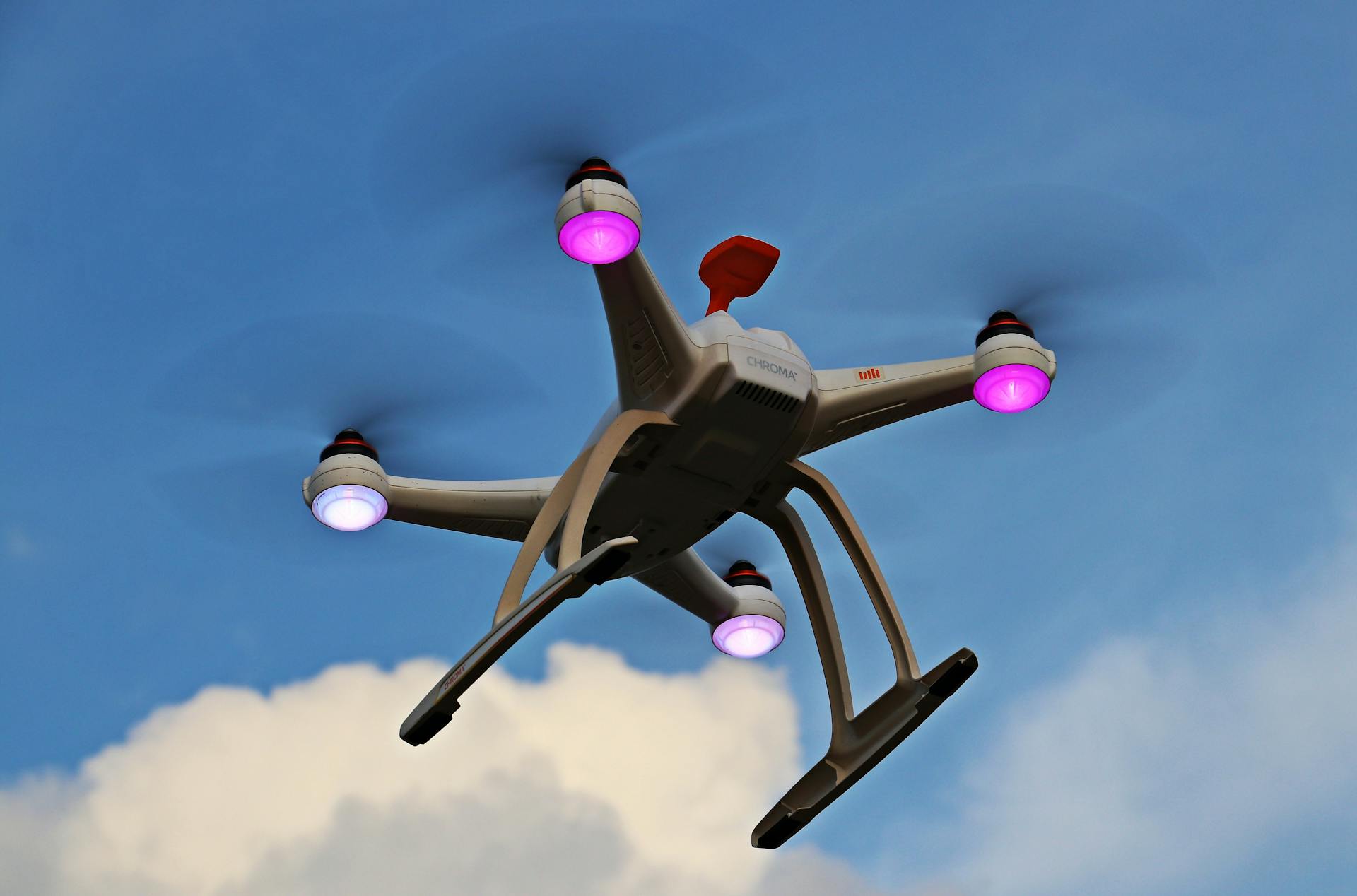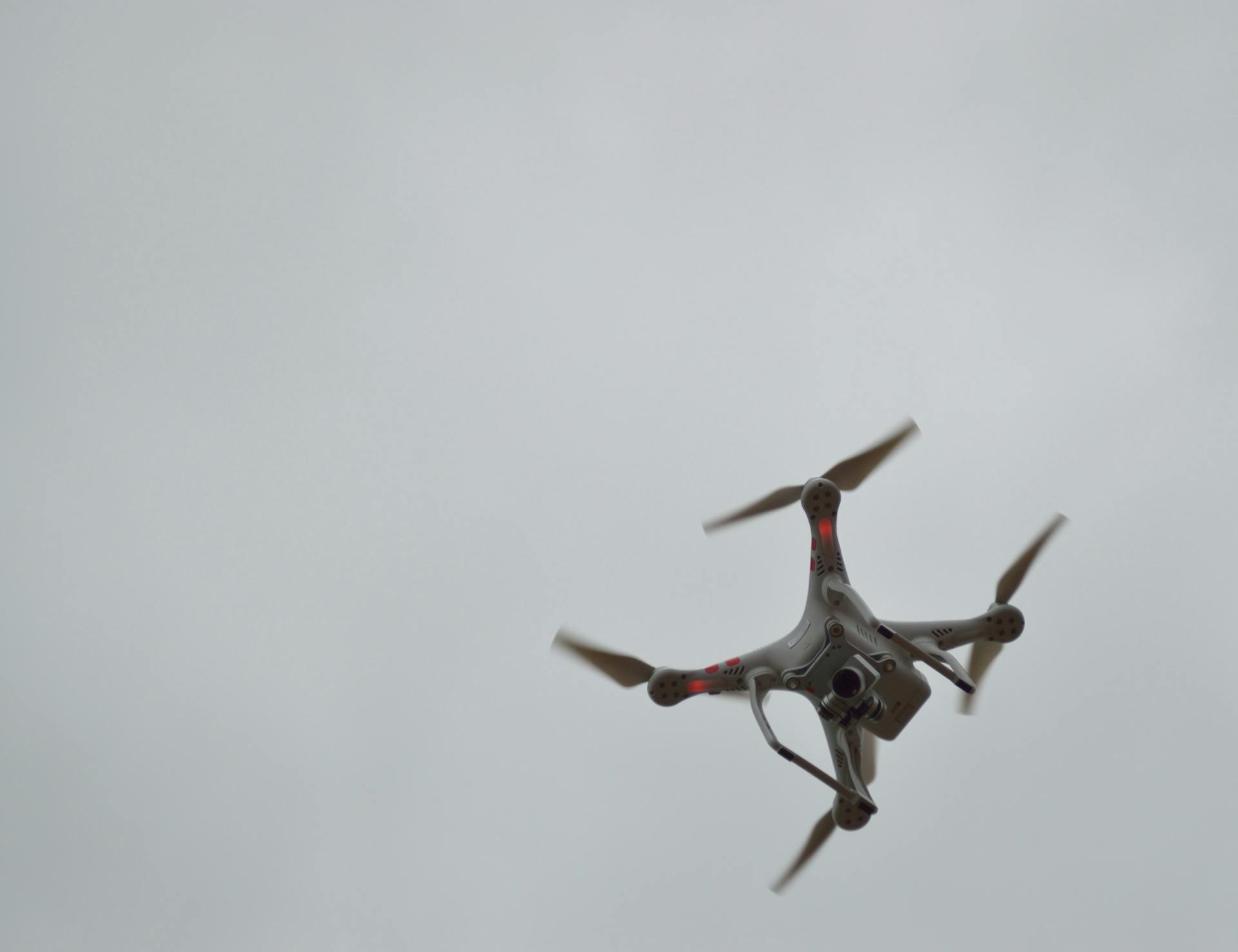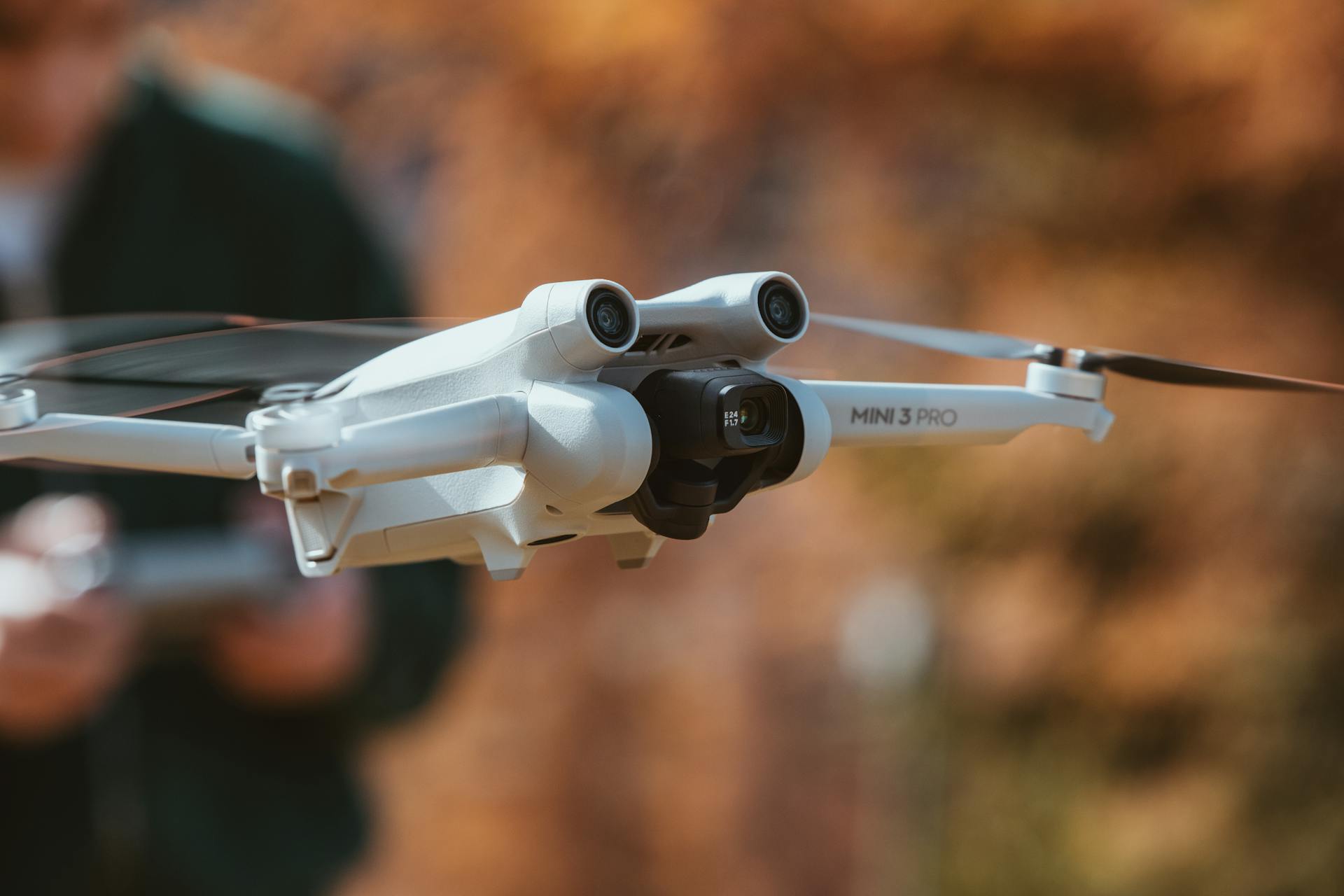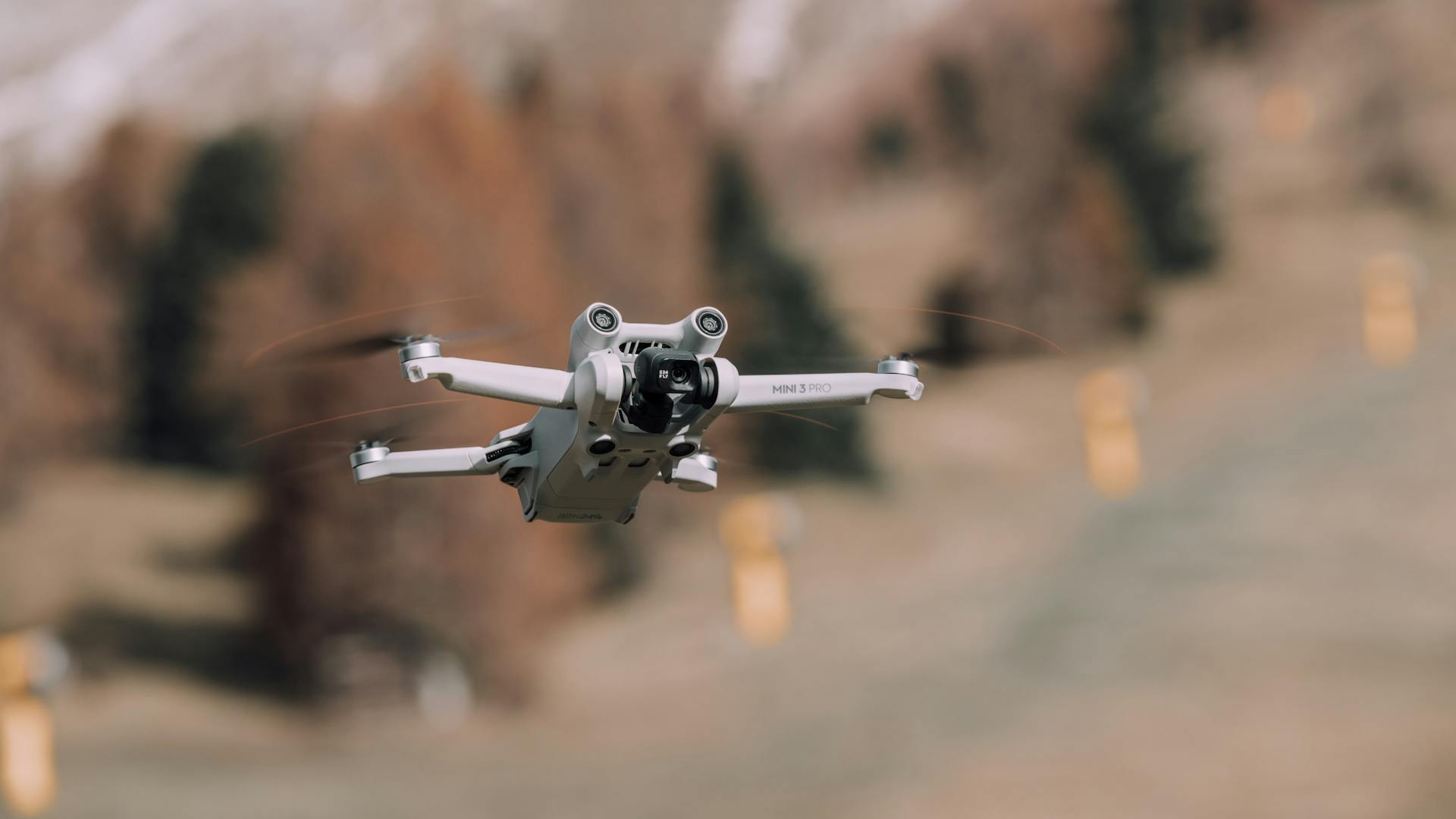
Quadrocopters are versatile machines with a wide range of applications. They can be used for aerial photography, capturing stunning views and unique angles.
In the field of aerial photography, quadrocopters have been used to capture breathtaking footage of landscapes, cities, and events. This is particularly useful for filmmakers and photographers who need to capture high-quality footage from unique perspectives.
With their ability to fly steadily and capture high-resolution images, quadrocopters have become a popular choice for aerial photography. They are also relatively easy to operate, making them accessible to a wide range of users.
Quadrocopters have also been used in military applications, where their ability to fly quietly and carry payloads makes them useful for surveillance and reconnaissance missions.
Suggestion: What Is Unmanned Aircraft Systems
Control Movement
Quadcopters have four basic control movements: lift, pitch, roll, and yaw. Lift control is achieved by spinning all four propellers at the same speed to produce the same amount of thrust, keeping the quad level.
Suggestion: Dji - Mini 2 Se Drone with Remote Control
To ascend, spin all four propellers equally faster, increasing thrust. To descend, lower the speed of all four propellers equally, reducing thrust.
Pitch control allows forward and backward movement by increasing and decreasing the speed/thrust on the two front and two rear propellers. A substantial speed difference between the front and rear props will cause the quad to flip forward or backward.
To pitch or flip forward, spin the rear propellers faster and produce more thrust than the fronts. To pitch/flip backward, spin the front propellers faster than the rears.
Roll control is achieved by increasing and decreasing the speed/thrust of the left and right side propellers. To move or roll right, increase the speed/thrust of both left propellers and decrease the speed/thrust of the right propellers.
Quadcopter yaw control is achieved by increasing or decreasing the speed of the two counter-clockwise (CCW) props in relation to the speed of the two clockwise (CW) props. This produces different amounts of reactive torque between the CCW and CW propellers.
To yaw/turn/rotate right, increase the speed of both CCW props and decrease it on the two CW props. To yaw/turn/rotate left, do the opposite and speed up the CW props while slowing down the CCW ones.
Variable pitch quadrocopters can perform more aggressive banking turns and quick deceleration due to their added maneuverability.
Design and Structure
Quadcopters generally have two rotors spinning clockwise and two counterclockwise, providing flight control through independent variation of speed and lift. This design allows for pitch and roll control by varying the net centre of thrust, while yaw is controlled by varying the net torque.
The rotors produce both lift and torque about their center of rotation, as well as drag opposite to the vehicle's direction of flight. This is why quadcopters don't have cyclic pitch control like conventional helicopters.
The main mechanical components of a quadcopter include a fuselage or frame, four rotors, and motors. For best performance, the motors and propellers are typically equidistant from each other.
Mechanical Structure
Quadcopters are incredibly simple machines with hardly any moving parts, compared to traditional helicopters. This mechanical simplicity is one of the key reasons why quadcopters are so easy to build and maintain.
The main mechanical components of a quadcopter include a fuselage or frame, four rotors, and motors. For optimal performance and control, the motors and propellers should be equidistant from each other.
In most cases, there are only four moving parts on a quadcopter: the four spinning motor shafts directly connected to the propellers. This minimalistic design makes quadcopters easy to customize and build inexpensively.
To get started with building your own quadcopter, you'll need a frame, motors, ESCs (electronic speed controllers), propellers, a receiver, a flight controller, and LiPo flight batteries.
Here's a list of the essential components you'll need to build a quadcopter:
- Frame
- Motors
- ESC's (electronic speed controllers)
- Propellers
- Receiver
- Flight controller
- LiPo flight batteries
This simplicity is also one of the reasons why quadcopters are so affordable, with entry-level models available for under $35.
Aerial Imaging
Aerial imaging has become a popular application of quadcopters, with many uses ranging from real-estate to sporting events.
These flying platforms offer superior lift efficiency and don't require much skill to pilot, making them ideal for capturing high-quality aerial footage and photos.
With electronic sophistication and onboard autopilot systems, quadcopters can provide a stable and pinpoint fixed position hands-off hover, freeing up the operator to focus on camera control.
The DJI Mavic Series leads the pack in aerial imaging, with the Mavic Pro 2, Air 2, and Mini quadcopters being top-rated and best-selling options.
These quadcopters come with a 4K video camera and stabilization gimbal, as well as various bundle packages based on specific imaging needs and budget.
DJI's GPS auto pilot and stabilization systems allow for hands-off hovering, even if the pilot gets out of radio range or engages the "return to home" function.
The Mavic's obstacle avoidance technology makes it easy for anyone to successfully fly a DJI Mavic while creating breathtaking aerial imagery.
With their advanced features and user-friendly design, it's no wonder why DJI Mavic quadcopters are the go-to choice for many aerial imaging applications.
Consider reading: Dji Phantom Dji Phantom 2
3D
3D quads were a short-lived experiment that never gained popularity in the marketplace. They could hover inverted and perform true 3D flight, similar to conventional collective pitch RC helicopters.
These quadcopters worked very well, but their unique capabilities didn't translate to commercial success. They were different from conventional quads, and understanding their design would require a separate writeup.
Coaxial

Coaxial designs allow for more power and stability at reduced weight, a key advantage in quadcopter design.
Using a coaxial rotor configuration, each arm can have two motors running in opposite directions, one facing up and one facing down.
This setup helps to cancel out vibrations and improve overall stability, making it a popular choice among quadcopter enthusiasts.
In quadcopters, coaxial rotors can be a game-changer, enabling more efficient flight and reduced weight.
Variable Pitch Flies
Variable pitch quadcopters are a type of quadcopter that can change the pitch of their blades, allowing for more maneuverability and control.
This design modification is fairly uncommon in remote control aircraft, but it leads to very cool flights, like having an airplane hover nose down.
Variable pitch quadrocopters can perform more aggressive banking turns when following a preprogrammed path due to their added maneuverability.
They can also stop on a dime, unlike fixed pitch quadcopters that continue climbing after being commanded to stop.
The first is trajectory generation, which allows for more complex flight paths and maneuvers.
The second benefit to their design is quick deceleration, making them more responsive to control inputs.
The variable pitch quadrocopter is designed by Mark Cutler and Jonathan P. Howe from the Aerospace Controls Laboratory.
Their design allows for more control and stability, making it a promising area of research for quadcopter development.
Safety and Features
RC quad/multi rotor safety is a big can of worms to open.
RC drone safety is an important topic many newbies to RC flight are unaware of.
A good "basics" primer video is available to get you started on understanding the safety considerations of RC quad/multi rotors.
Vortex Ring State
The vortex ring state is a phenomenon that can occur in quadcopters, just like in traditional rotorcraft. It's caused by the rotor blades creating a vortex ring that can pull the aircraft down.
Quadcopters are subject to this aerodynamic condition, which can be a concern for pilots. This is due to their rotor design, which creates a vortex ring state.
As a quadcopter pilot, it's essential to understand the risks and take necessary precautions to avoid entering this state. This can be done by maintaining a safe altitude and airspeed.
Multi Safety
Multi Safety is a big concern for RC pilots, and it's essential to be aware of the risks involved.
RC Quad/multi rotor safety can be a complex issue, but it's crucial to address it.
Newbies to RC flight often overlook the importance of safety, but it's a critical aspect to master.
I've covered RC drone safety in detail on my "RC Drone Page", and it's a must-read for anyone interested in RC flight.
RC Quad/multi rotor safety basics are covered in a good primer video that's worth watching.
RC pilots need to be aware of the risks and take necessary precautions to ensure a safe flying experience.
Types and Variations
Quadrocopters come in various sizes, measured by the diagonal distance between motor hubs, which can range from 150 to 450mm and beyond.
Most quadrotors have a size number that refers to this diagonal distance in millimeters. This measurement is crucial for understanding the size and capabilities of a quadrocopter.
Quadrocopters with more arms, like hexa and octa rotors, are measured differently, with a focus on the distance between motor hubs on adjacent arms.
Aerial Photography & Video & FPV
Aerial photography and video have become incredibly accessible with the rise of quadrocopters. These flying platforms are perfect for capturing stunning footage from unique perspectives.
With their ability to fly themselves, hover, and provide superior lift efficiency, quadrocopters have become a popular choice for various applications, including real-estate, sporting events, and wildlife photography.
One of the key benefits of using quadrocopters for aerial imaging is their autopilot systems, which provide a very stable and pinpoint fixed position hands-off hover. This gives the operator the freedom to focus on camera control.
The DJI Mavic series stands out as a top-rated and best-selling option for aerial imaging. Their quadcopters come equipped with 4K video cameras, stabilization gimbals, and various bundle packages to suit different needs and budgets.
DJI's Mavic quadcopters also feature obstacle avoidance technology, making it possible for anyone to successfully fly them while capturing breathtaking aerial imagery.
Intriguing read: Dji Innovations Mavic Pro
Drones: Size Variations
Quadrotors are often sized by their diagonal distance in millimeters from each motor's center, also known as the motor hub to motor hub measurement.
This measurement is usually expressed as a single number, such as 150, 210, 350, or 450, which corresponds to the diagonal distance between the motor hubs.
Most quadrotors on the market follow this measurement standard, making it easier to compare and choose between different models.
Hexa and octa rotors, on the other hand, are measured from motor hub to motor hub on adjacent motor arms.
A 350 size quadrocopter, for example, has a diagonal distance of about 350mm from motor hub to motor hub.
This size variation is important to consider when choosing a drone, as it affects the drone's stability, maneuverability, and overall performance.
Everywhere
Quadrocopters can be found everywhere, and their designs are inspired by various sources, such as the Japanese spherebot.
Their frames can be made of materials like carbon fiber, which helps prevent them from bumping into things, but it doesn't protect them from other objects bumping into them.
Autonomy and Endurance
Quadcopters can be programmed for autonomous flight with relative ease, making them a great platform for experimenting with complex swarming behavior.
This simplicity has led to some fascinating experiments with basic sensing of adjacent drones.
The longest flight time achieved by a battery-powered quadcopter was 2 hours, 31 minutes and 30 seconds, set by Ferdinand Kickinger of Germany in 2016.
Autonomous Flight
Autonomous flight is a game-changer for drones, allowing them to navigate and perform tasks on their own. The quadcopter configuration is relatively simple to program for autonomous flight.
This simplicity has enabled researchers to experiment with complex swarming behavior, where multiple drones work together based on basic sensing of their surroundings.
Endurance
The key to achieving autonomy in drone technology is often tied to endurance.
The longest flight time achieved by a battery-powered quadcopter was 2 hours, 31 minutes and 30 seconds.
Ferdinand Kickinger of Germany set this record in 2016 using low discharge-rate, high-capacity lithium-ion batteries.
Stripping the airframe of non-essential weight also helped reduce power draw and extend endurance.
Alternative power sources like hydrogen fuel cells and hybrid gas-electric generators have been used to dramatically extend endurance.
Both hydrogen and gasoline have increased energy density, allowing for longer flight times.
Worth a look: Ar Drone Parrot 2.0 Power Edition
Military and Advanced Use
Recreational and commercial drones have been adapted for military use, particularly during the 2022 Russian invasion on Ukraine. They were initially used to compensate for a lack of aerial and satellite reconnaissance.
In the heat of battle, these drones have proven to be "game changers" by serving as small bombers and loitering munitions.
Military Use
Military use is a significant aspect of drone technology. Initially, Ukrainian and Russian armed forces started using recreational and commercial drones in the 2022 Russian invasion on Ukraine.
The main reason for this adoption was to compensate for the lack of aerial and satellite reconnaissance. This lack of resources put them at a disadvantage.
Drones quickly proved to be a game changer, with Russian forces using them as small bombers and loitering munitions on a large scale.
S.H.I.E.L.D. Heli Carrier
The S.H.I.E.L.D. Heli Carrier is a remarkable example of creative engineering, brought to life by [Native18] in a quad copter reproduction. This impressive model is made mainly of paper and lightweight foam.
It's capable of floating and even taking off from water, a feat that's rarely achieved in aircraft carrier designs. This model showcases the versatility and ingenuity of its creator.
The Heli Carrier's construction is a testament to the power of innovation, pushing the boundaries of what's possible with everyday materials.
Frequently Asked Questions
What is the difference between a drone and a quadcopter?
A drone is a broader term that refers to any unmanned aerial vehicle, while a quadcopter specifically describes a type of drone with four rotors. Understanding the difference is key to exploring the diverse world of drones beyond just quadcopters.
What is the difference between a quadcopter and a quadrotor?
There is no difference between a quadcopter and a quadrotor, as both terms describe an uncrewed rotary wing aircraft with four rotors. The terms are often used interchangeably, but quadcopter is a more commonly used term in consumer and hobbyist contexts.
Are quadcopters better than helicopters?
Quadcopters are not inherently better than helicopters, as they can be less stable and less efficient. However, their unique design offers advantages in terms of agility and maneuverability.
Why are there no big quadcopters?
Big quadcopters are limited by their propellers, which become harder to control as they grow in size due to increased momentum. This makes them less agile and responsive compared to smaller models.
Featured Images: pexels.com

